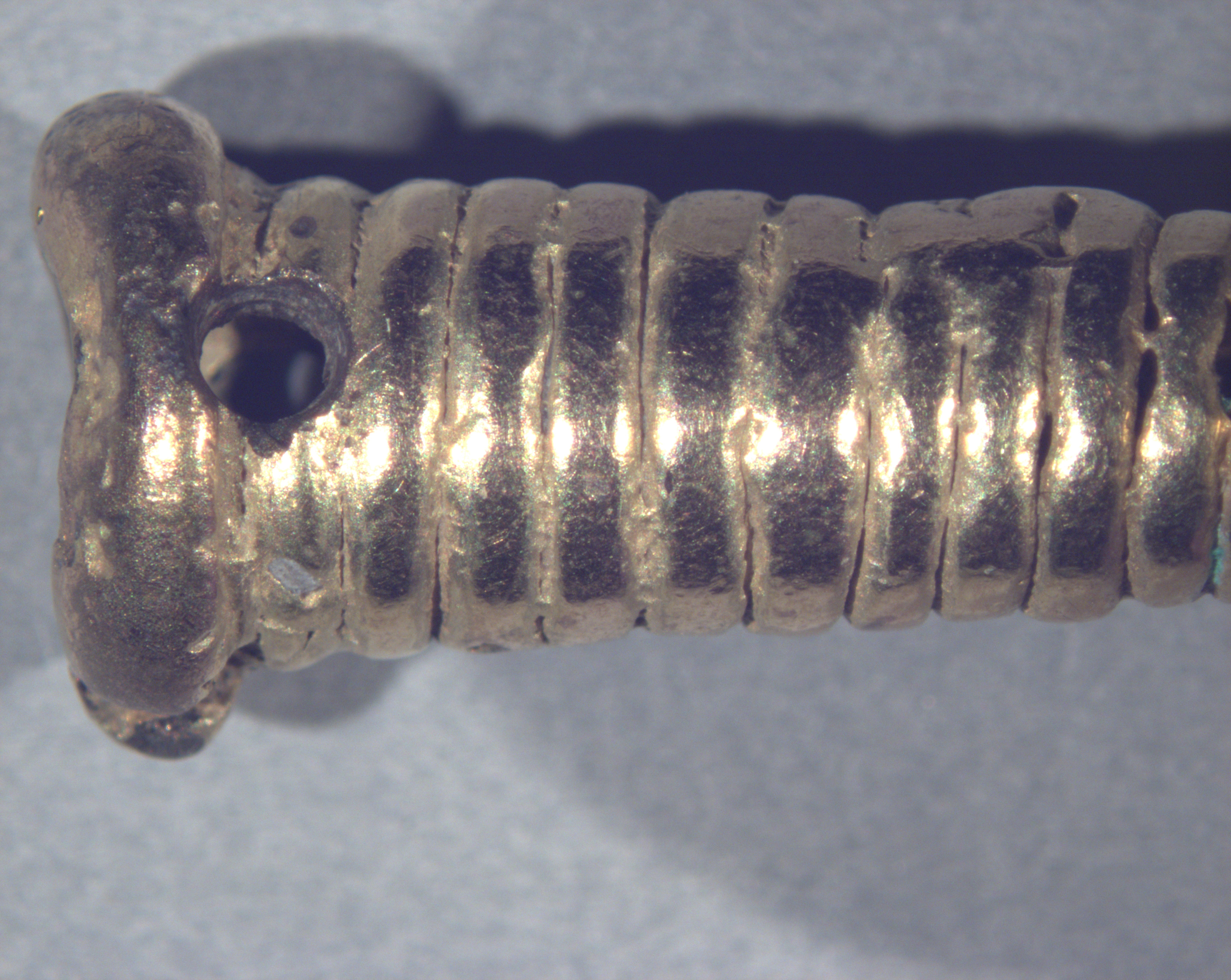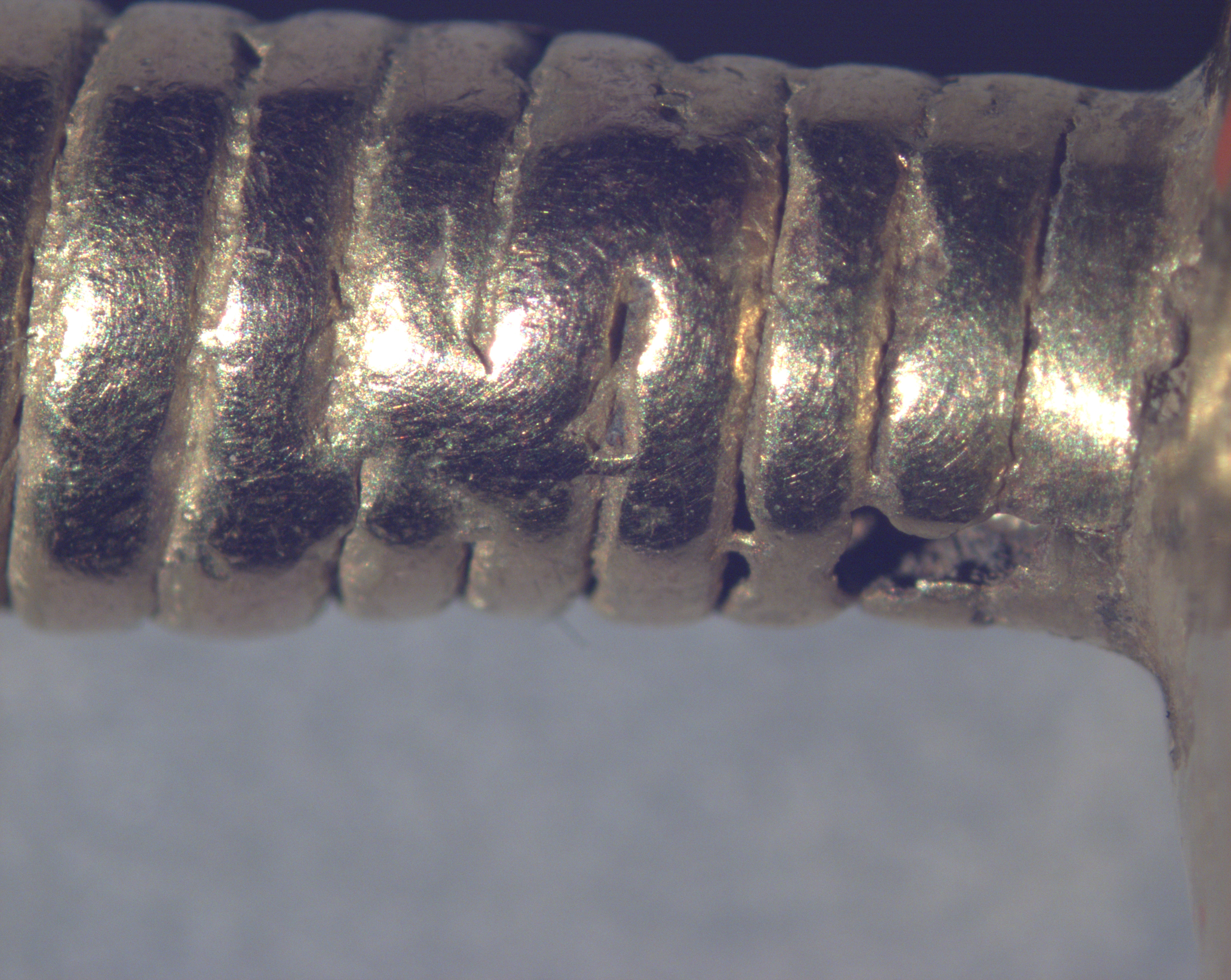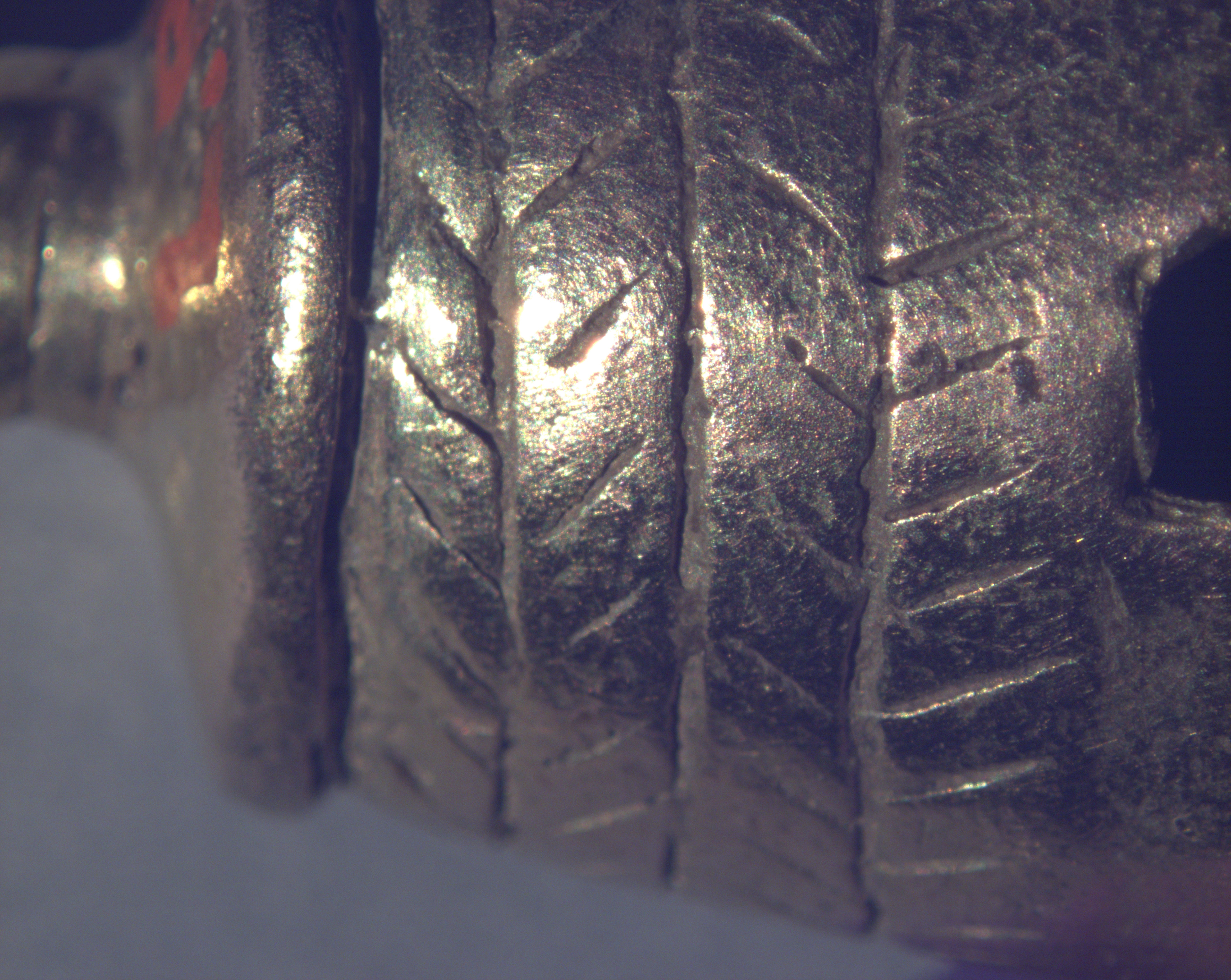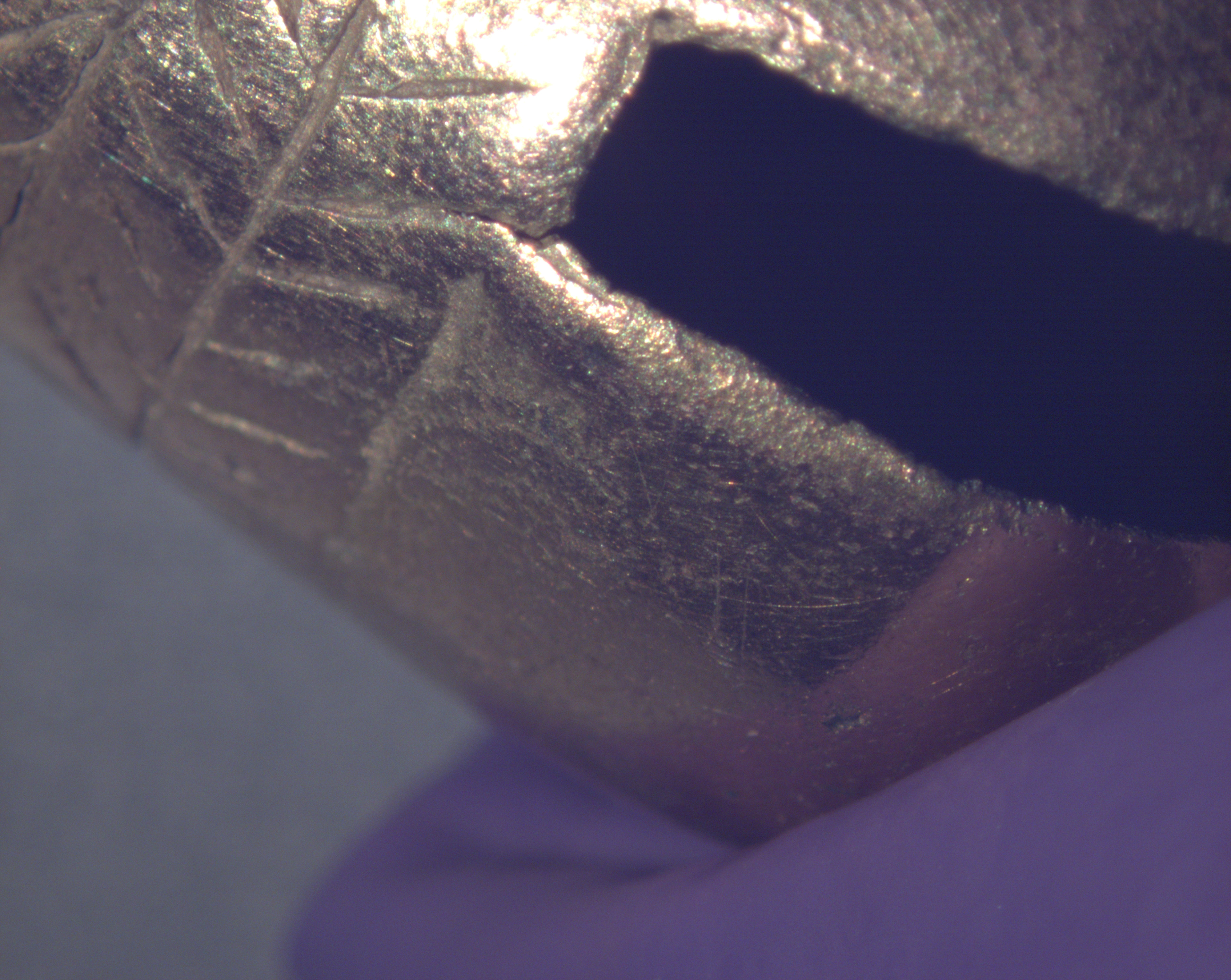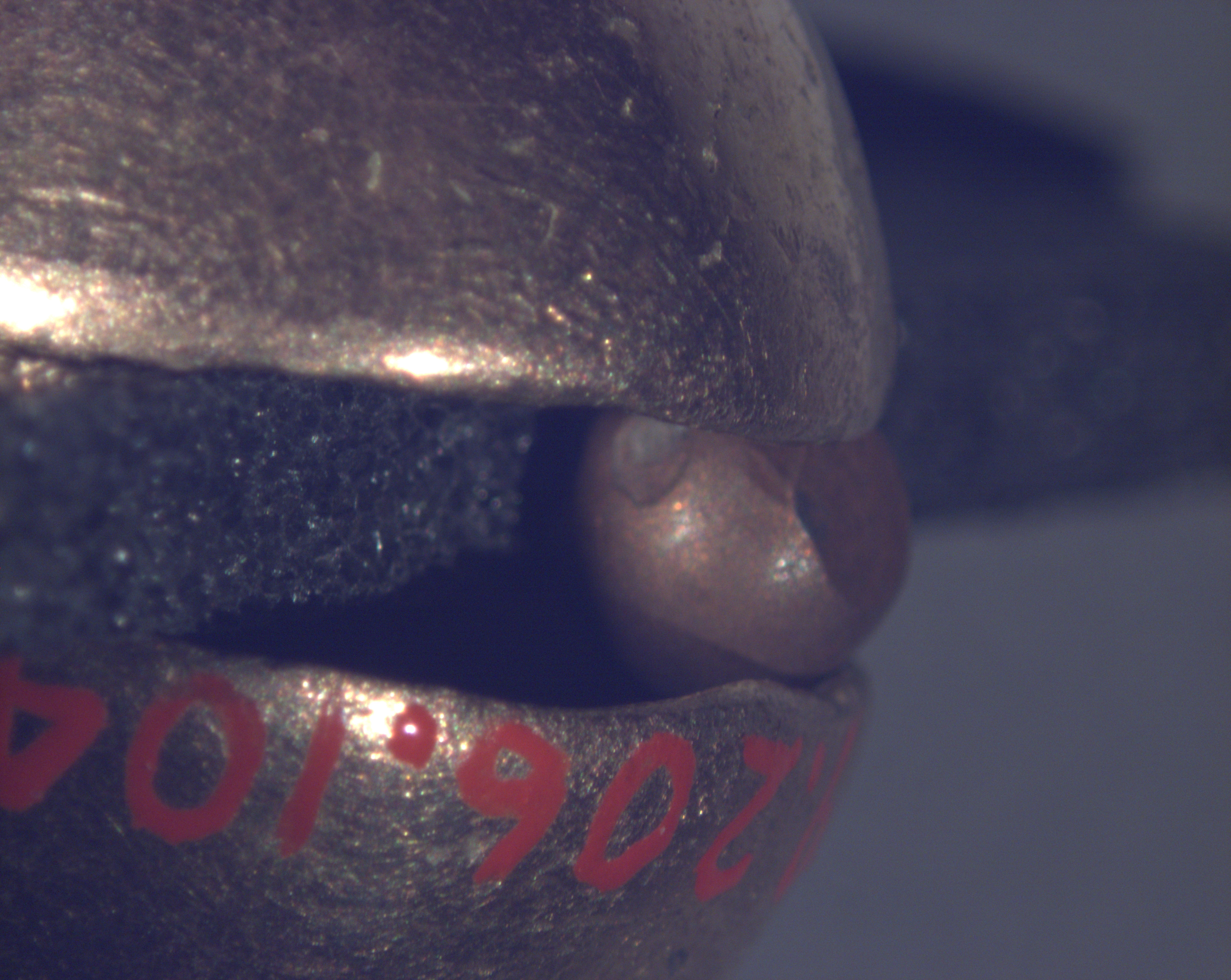Bell
Not on view
Technical note: Optical microscopy and XRF conducted in 2017.
This bell was cast by the lost wax process, and all design elements—including the four registers of diagonal lines on the outside of the resonator—were created in the wax model. The bell has a long hollow stem (1.8 cm long) (see image 2)—a feature especially distinctive of some Greater Coclé bells—that leads to the bulbous resonator. The stem was created by wrapping a long wax thread around a thin cylindrical organic element that was later removed or burned out during the casting, and the hollow resonator was formed in wax sheet applied over a ceramic core, which contained the previously cast clapper ball element imbedded within it. After casting, the core was also removed from the interior of the resonator, leaving behind the spherical clapper to move freely within the metal cavity. If we shake the bell, the motion of the clapper striking the walls creates a light, watery sound. Also, after casting, the top of the stem was drilled to provide a means for suspension.
The metal used to create the bell is a gold alloy whose surfaces were chemically treated after casting in order to remove some of the copper and to make the metal appear more gold-rich in color. At present, the projecting rims of both the stem and resonator are slightly pinker in color than other areas due to excessive polishing or handling of the gold in these areas, causing some of the enriched surface to be lost. The metal of the clapper on the other hand appears to be an alloy of copper and iron. Irregularly shaped losses in the stem of the bell near the base and areas of slumped metal in the stem above, suggest that minor problems occurred during casting that affected the flow of molten metal. These flaws were probably left unchanged as their presence did not alter the general appearance or functionality of the bell.
Metal bells have been recovered from a range of Central American and Colombian contexts but are more typical of the International Group of metals, dating typically to after A.D. 500 and which involved object fabrication in the Isthmus, than of the Initial Group, which includes metal imported to the Isthmus made by practitioners of the Urabá and Quimbaya metallurgical traditions, among others, in Colombia (Cooke and Bray 1985). This bell has a form and design that is analogous to some from the Greater Coclé region. Before discussing the Coclé bells in more detail, it is important to note that at least one similar bell is reported to have come from the Southern Pacific region of Costa Rica (BCCR-O-16) (see Molina and Aguilar 2015, fig. 30). It has a pear-shaped resonator, a long stem, a wire-like design that extends from the resonator onto the stem, and a perforation at the stem’s end.
Several similar bells were recovered from Sitio Conte during excavations in the early 1930s including at least two from Grave 1 and one from Grave 29. Sitio Conte is a large funerary complex that was likely in use between ca. A.D. 750 and A.D. 950. Some of the bells from this site show a false filigree stem, which includes a repeated spiral motif (Lothrop 1937, fig. 74a,c, 75a), while others (Lothrop 1937, fig. 74b (which is one of PMAE 33-42-20/714), f) show a zoomorphic design formed out of the stem. Some have spherical resonators (Lothrop 1937, fig. 74b,f, 75a-b) while others have pear-shaped resonators (Lothrop 1937, fig. 74a, c).
A bell (#9327) (4.1 cm high) with a long stem, displaying a series of false filigree spirals, and a relatively spherical resonator with some relief spiral design, was recovered from Tomb 2, associated with Individual 7, at the site of El Caño. One radiocarbon analysis associated with burials in this tomb yielded a date range of A.D. 900-1020 [calibrated] (Mayo and Mayo 2013, 16). The site is a large funerary complex likely associated with that of Sitio Conte, 2.5 km to the south, also containing a 15-m long stone pathway bridging the site and the Río Grande and a formation of 81 basalt columnar sculptures. Tomb 2 is the largest and most complicated of the tombs so far excavated, consisting of three levels of human internments. Also from Tomb 2, but apparently unassociated with a particular individual, a long-stem bell (#AU10344) that is 4.5 cm high has a plain pyriform resonator with two circumferential relief bands near its top, separated from the finial by two further bands. The stem is decorated with two reptilian figures in profile, each with scales along the back of its head, an open mouth, and hands in a curved, open position as if ready to grab onto prey. Another El Caño bell (#7576) (5.2 cm high) with a long stem shows no decoration on the stem or pyriform resonator. It was recovered from Tomb 6, dated to A.D. 775–790 [calibrated]/A.D. 800–980 [calibrated], where two human interments were found along with metal objects not directly associated with the human remains (Mayo and Mayo 2013, 21).
In 1519, the Spanish colonist Gaspar de Espinosa was part of a group that came across funerary bundles near the site of El Hatillo located inland, west of the Parita Bay, and part of the Greater Coclé archaeological region. The colonists, in a way similar to archaeologists, unwrapped the multiple layers of cloth that contained the bodies and came across a range of gold ornaments on one of them including a gold belt from which were hanging gold bells. At present, questions remain over how often people wore bells as isolated objects or as groups, and when they occurred in groups, whether people wore bells with similar or varied designs.
Today, Kuna or Gunadule peoples who have migrated over time westward and now occupy lands in the Darién region and the San Blas Islands, east of the Greater Coclé region, use music in the transmission of knowledge, playing rattles, panpipes, and deer and jaguar skulls as well as singing or chanting (Smith 1997, 299). Musicians may play an instrument in groups, each person playing the same instrument but a different part. Sometimes they play different instruments together to create a sound that will expel malevolent spirits.
Bryan Cockrell, Curatorial Fellow, Arts of Africa, Oceania, and the Americas
Beth Edelstein, Associate Conservator, Objects Conservation
Ellen Howe, Conservator Emerita, Objects Conservation
Caitlin Mahony, Assistant Conservator, Objects Conservation
2017
Related objects: 1977.187.20, 1979.206.483a, b, 1979.206.550, 1979.206.729, 1979.206.956
References
Cooke, Richard G., and Warwick M. Bray. 1985. "The Goldwork of Panama: An Iconographic and Chronological Perspective." In The Art of Precolumbian Gold: The Jan Mitchell Collection, edited by Julie Jones, 35-45. Boston: Little, Brown and Company.
Lothrop, Samuel K. Coclé: An Archaeological Study of Central Panama. Memoirs of the Peabody Museum of Archaeology and Ethnology, Harvard University vol. 7, pt. 1. Cambridge: Peabody Museum of Archaeology and Ethnology, 1937.
Mayo, Julia, and Carlos Mayo. 2013. "El descubrimiento de un cementerio de élite en El Caño: Indicios de un patrón funerario en el Valle del Río Grande, Coclé, Panamá." Arqueología Iberoamericana 20: 3-27.
Molina Muñoz, Priscilla and Mónica Aguilar Bonilla. La metaìfora de los sonidos: Materializacioìn de la muìsica en las poblaciones precolombinas. San Joseì, Costa Rica: Fundacioìn Museos Banco Central de Costa Rica, 2015.
Smith, Sandra. 1997. "The Musical Arts of the Kuna." In The Art of Being Kuna: Layers of Meaning Among the Kuna of Panama, 292-309. Los Angeles: UCLA Fowler Museum of Cultural History.
This image cannot be enlarged, viewed at full screen, or downloaded.
This artwork is meant to be viewed from right to left. Scroll left to view more.


